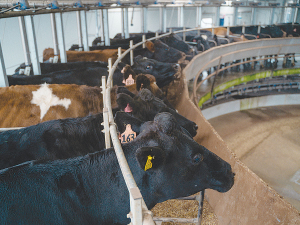Mineral Balance: The hidden key to dairy goat health & production
Most dairy goat farmers focus on getting energy, protein, and fibre right, and fair enough – feed drives milk.
 A well transitioned cow will normally produce more milk, have fewer disease issues, and a better reproductive outcome.
A well transitioned cow will normally produce more milk, have fewer disease issues, and a better reproductive outcome.
Making key decisions around feeding and supplementation for springer cows can have a bigger impact on a dairy farm’s profitability than any other single set of management decisions made throughout the rest of the season.
Both the period prior to calving and the period after calving are equally important to ensure a cow will produce at her potential. A well transitioned cow will normally produce more milk, have fewer disease issues, and a better reproductive outcome, than cows that don’t receive as much attention around this time.
A cow that is not transitioned correctly leading up to calving can suffer from clinical or subclinical metabolic disease leading to a host of issues that can last through next lactation.
This can be caused by a true calcium deficiency, or the limited ability to mobilise sufficient calcium, this can be further complicated by ketosis, fatty liver disease, or even a combination of these problems.
For any cow, this is a period of vast metabolic change. Their hormone levels are kicking into gear as the body gets ready to mobilise many of the key minerals required for calving and lactation, as well as preparing the body to mobilise the vast amounts of energy required. Transition is the single highest stress period a cow will experience each year.
A good transition diet will ensure that the transition cow receives at least minimum levels of calcium, phosphorous, and sodium, while magnesium and trace elements are also being well maintained. The pre-calving diet should also be as low in potassium as possible so as not to limit calcium uptake.
Cows will also most likely be low in at least some of the trace elements during this period, and unless addressed, a deficiency can negatively affect the capacity of the liver to metabolise the necessary energy levels required through calving and early lactation. Correct supplementation can be critically important at this time, especially if body storage levels of these required minerals are already low.
The simple process of correctly transitioning a cow throughout this period will ensure good blood calcium levels are maintained and a high rate of calcium mobilisation can be achieved throughout lactation. Research has consistently shown that cows with high blood levels of calcium during early lactation also have a higher neutrophil function (increased immunity). Over the years there has been a large body of research linking blood calcium levels with metritis, RFM’s, displaced abomasum’s and issues with poor reproductive performance, clearly showing the importance of achieving adequate blood calcium levels (>8,59 mg/dl) in dairy cows at key times.
Agvance Nutrition in association with your vet have the software tools to accurately calculate the ideal transition diets for your cows. We can build blends for both the pre-calving and post-calving periods, and we also offer free advice around correct feeding and management throughout this period.
Chris Balemi is Managing Director of Agvance Nutrition Limited
The University of Waikato has broken ground on its new medical school building.
Undoubtedly the doyen of rural culture, always with a wry smile, our favourite ginger ninja, Te Radar, in conjunction with his wife Ruth Spencer, has recently released an enchanting, yet educational read centred around rural New Zealand in one hundred objects.
Farmers are being urged to keep on top of measures to control Cysticerus ovis - or sheep measles - following a spike in infection rates.
For more than 50 years, Waireka Research Station at New Plymouth has been a hub for globally important trials of fungicides, insecticides and herbicides, carried out on 16ha of orderly flat plots hedged for protection against the strong winds that sweep in from New Zealand’s west coast.
There's a special sort of energy at the East Coast Farming Expo, especially when it comes to youth.
The avocado industry is facing an extremely challenging season with all parts of the supply chain, especially growers, being warned to prepare for any eventuality.
OPINION: Dipping global dairy prices have already resulted in Irish farmers facing a price cut from processors.
OPINION: Are the heydays of soaring global demand for butter over?